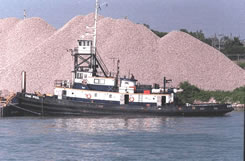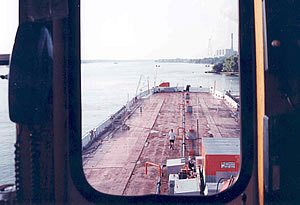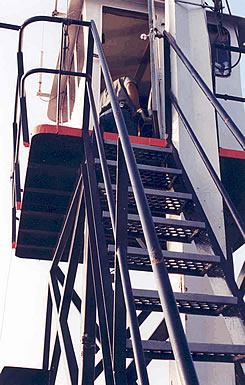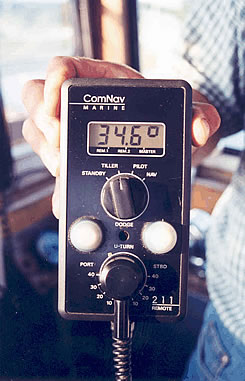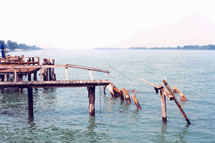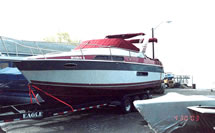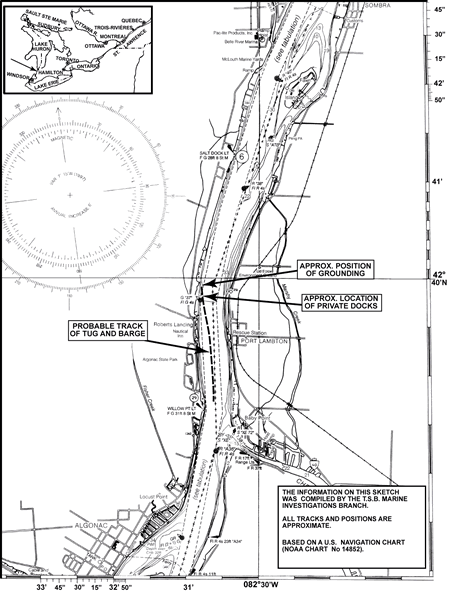Striking
of private docks and a pleasure craft
by tug and barge Evans McKeil and Ocean Hauler
St. Clair River, Michigan, United States
The Transportation Safety Board of Canada (TSB) investigated this occurrence for the purpose of advancing transportation safety. It is not the function of the Board to assign fault or determine civil or criminal liability. This report is not created for use in the context of legal, disciplinary or other proceedings. See Ownership and use of content. Masculine pronouns and position titles may be used to signify all genders to comply with the Canadian Transportation Accident Investigation and Safety Board Act (S.C. 1989, c. 3).
Summary
In the early morning hours of 10 July 2004, while proceeding upbound in the St. Clair River in calm and clear conditions, the barge Ocean Hauler, pushed by the tug Evans McKeil, struck and knocked down several private docks and severely damaged a pleasure craft on the United States side of the river. The tug and barge continued ahead a short distance until the tug ran aground. There was no pollution and no one was injured.
Factual information
Particulars of the vessels
| Name | "EVANS MCKEIL" | "OCEAN HAULER" |
|---|---|---|
| Official number | 810988 | 817048 |
| Port of registry | Hamilton, Ontario | Hamilton, Ontario |
| Flag | Canada | Canada |
| Type | Tug | Tank/Deck Barge |
| Gross tonnage | 284.2 | 3781 |
| LengthFootnote 1 | 31.94 m | 98.45 m |
| Draught | Forward: 3.05 m Aft: 3.96 m | Forward: 1.52 m Aft: 1.67 m |
| Built | 1936, Balboa, Panama | 1942 |
| Propulsion | One 1604 kW diesel engine | None |
| Cargo | Nil | Nil |
| Crew | 6 | Nil |
| Owners | McKeil Marine Limited | McKeil Marine Limited |
Description of the tug and barge unit
The Evans McKeil is a tug of steel construction and has two conning positions. An elevated "upper" wheelhouse is located on a vertical gantry above the main "lower" wheelhouse. Which wheelhouse is used depends upon whether the barge is carrying dry cargo on its open deck, or liquid cargo in its tanks. When the barge is in ballast or unladen, only the upper wheelhouse is used to provide the best line of sight (see photo 1 and photo 2).
Although the upper wheelhouse can accommodate two persons, there is only room for one navigating officer at the forward wheelhouse windows, and it presents a challenge to correctly position a second person as lookout. However, a clear view can be had from an exterior catwalk around the perimeter of the wheelhouse platform.
A person leaving the upper wheelhouse must go down 15 steps on the gantry stairway to the top of the lower wheelhouse (see Photo 3), descend a ladder to the bridge deck, then walk several metres toward the stern and climb down another deckhouse ladder to reach the main deck. The estimated time to accomplish this safely is approximately 1 minute 30 seconds. The master's cabin is located on the bridge deck immediately aft of the lower wheelhouse.
In the pushing mode, the stem of the tug is secured at the pushing point, a 1.5 m deep, V-shaped indent located at the stern of the barge. An additional set of securing wires from the stern of the tug keeps the centreline of the tug in line with the centreline of the barge.
The Ocean Hauler is a flat-topped steel tank/deck barge. Although used primarily for the carriage of liquid cargo, it is also capable of carrying dry cargo on the open deck. Since the beginning of the shipping season, the barge was being used solely for transporting brine. Trailer units are secured on the starboard quarter of the barge to house cargo handling machinery and a small office.
Navigation equipment
Navigation equipment in the upper wheelhouse includes a 3 cm radar, gyrocompass, an electronic chart system (ECS) with raster chart display on a laptop computer integrated with a Differential Global Positioning System (DGPS), Automatic Identification System (AIS), and a hand-held remote steering controller. There is a small drop-leaf table space to starboard of centre for the placement of a folded chart or chartlet. It is normal practice for the master or first officer to be on duty alone in the wheelhouse. The instrumentation and steering station is duplicated in the lower wheelhouse. There is a ship's telephone connected to different locations on the tug.
The remote steering controller has switch settings for four modes; "Standby," "Tiller," "Pilot," and "Nav," and above the switch is a small rectangular LED display that indicates the rudder angle/course change setting in degrees (see Photo 4).
- "Standby" - There is no control as steering pumps are ready for use but not effective.
- "Tiller" - The rudder is moved "X" number of degrees, port or starboard, to a maximum of 35 degrees and it will remain in the "X" position set by the lower switch.
- "Pilot" - The rudder is moved automatically to maintain a specific course heading input to the remote controller.
- "Nav" - The rudder is moved automatically port or starboard to attain a one-degree course change with each press of either the white port or starboard buttons.
History of the voyage
At 2045 eastern daylight timeFootnote 2 on 09 July 2004, the tug Evans McKeil, with its bow made fast to the stern of the empty barge Ocean Hauler, departed Amherstburg, Ontario, proceeding upbound in the Amherstburg Channel section of the Detroit River. The voyage to Courtright, Ontario, takes approximately nine hours to complete and the preferred steering mode setting on the controller is "Tiller" for 95 per cent of the time. Because the barge was in a light draught condition, the upper wheelhouse was used for navigation purposes. Whenever there was little or no traffic in the vicinity, the tug-barge unit would take the shortest direct route along whichever side of the navigation channel saved time at turns in the river.
Shortly before midnight, the first officer relieved the master.
At 0140, on July 10, the tug-barge unit was passing light "X32" in the southwestern reaches of the St. Clair Cutoff Channel when the last entry in the bridge navigation logbook was made.
At 0330, the first officer was alone on watch piloting the unit and performing all the navigation functions including operation of the remote steering controller, which was set to "Tiller." The unit was moving at near full ahead speed of about 6.7 knots in calm conditions with good visibility.
At 0335, the tug-barge unit was abeam of Algonac State Park, Michigan, United States, and was tracking to port of the centre of the channel at approximately one quarter of the width of the channel from the United States shoreline. There was no traffic in the immediate vicinity at that time and the first officer prepared to leave the upper wheelhouse to use the washroom on the main deck. He was aware of the unit's approach position relative to buoy G37 and the shoreline and that a course change was imminent. The steering control unit was switched from the "Tiller" setting to another mode (intended to be "Pilot"), then the first officer left the upper wheelhouse unattended. Meanwhile, the captain remained asleep in his cabin on his six-hour rest period.
Information recorded by the Marine Communications and Traffic Services (MCTS) at Sarnia, Ontario, indicates that the course being steered by the tug-barge unit at this time was 355° true (T) with a speed of 6.2 to 6.3 knots over the ground. It was also indicated that, by 0336, the unit had altered course from 355°T to 336°T or 19° to port.
When the first officer was returning to the upper wheelhouse, the tug-barge unit was heading on a converging course with the shoreline; between buoy G37 and the shoreline, which was approximately 25 m away. Upon arrival in the upper wheelhouse, he attempted to switch the remote steering controller to the "Tiller" setting to change the direction of the unit. Initially, the helm did not respond but, within seconds, the "Tiller" setting was properly engaged to bring the rudder hard over to starboard.
At 0337:20, the unit altered course to starboard to 359°T and the tugs's engine was put to "full astern" as the barge struck some private mooring docks and severely damaged a 10 m pleasure craft (see photo 5 and photo 6). The unit continued on through shallowing water.
At 0340, the tug ran aground due to its draught being almost twice that of the barge but remained connected to the floating barge. The grounding occurred at position 42°39′50″ N and 082°30′51″ W, some 30 m north of light buoy G37 in the lower St. Clair River (see Appendix A).
Damage
Both tug and barge remained undamaged. However, six privately owned mooring docks were damaged and one pleasure craft was rendered a constructive total loss.
Personnel certification and experience
The first officer held a First Mate, Local Voyage Certificate. He had worked aboard various types of vessels for 35 years, 14 months of which were with McKeil Marine Ltd. During this time, he acquired experience as navigating officer and fullfilled the Great Lakes Pilotage Authority (GLPA) trip requirements for conducting pilotage.
The master held a Home Trade and Near Coastal Certificate for a ship of less than 3000 gross tons since 1990. He also fullfilled the GLPA requirements for conducting pilotage.
The vessel carried the minimum number of persons required by regulations, but there was no watchkeeping engineer (Fourth Class) or Bridge Watchman certificate holder on board at the time.
Hours of work and rest practices
The 72-hour work history revealed that the officer of the watch (OOW) and the master met the hours of rest requirements of the Crewing RegulationsFootnote 3 pursuant to the Canada Shipping Act. The first officer joined the tug Evans McKeil at its 2004 spring refit in Hamilton and the master joined on 08 July 2004 as relief master. Although the master performed all the docking and undocking manoeuvres, they worked shifts of 6 hours on duty followed by 6 hours of rest.
Analysis
Navigation in restricted waterways
The waters of the connecting channels between Lake Erie and Lake Huron (including the St. Clair River) constitute a compulsory pilotage area.Footnote 4 The Evans McKeil, however, was exempt. The demands on navigating personnel and the workload associated with navigation of the vessel in restricted waterways are high. Given that the pilotage requirements are for the enhancement of safe navigation in Canadian pilotage waters, it is essential that adequate consideration be given to the principles of watch composition with a view to ensuring that the workload is manageable and that all aspects of navigation in confined waterways, including monitoring of the vessel's progress, steering and lookout functions, can be effectively carried out.
Watch composition and crew performance
There are basic, internationally recognized principles to be observed in keeping a navigational watch and in having proper watch arrangements.Footnote 5, Footnote 6
- The composition of the watch shall at all times be adequate and appropriate to the prevailing circumstances and conditions and shall take into account the need for maintaining a proper lookout.
- When deciding the composition of the watch on the bridge which may include appropriate deck ratings, the following factors, inter alia, shall be taken into account:
- at no time shall the bridge be left unattended;
- weather conditions, visibility and whether there is daylight or darkness;
- proximity of navigational hazards which may make it necessary for the officer in charge of the watch to carry out additional navigational duties;
- use and operational condition of navigational aids such as radar or electronic position-indicating devices and any other equipment affecting the safe navigation of the ship;
- whether the ship is fitted with automatic steering;
- any unusual demands on the navigational watch that may arise as a result of special operational circumstances.
During the course of the voyage of the tug Evans McKeil and barge Ocean Hauler, the bridge was crewed by a single person and all of the factors for watch composition were not taken into account. This led to the following degradation in the performance of navigational tasks by a one-person bridge crewing that culminated in the accident.
Lookout
A separate lookout was not posted, requiring the OOW to assume this added responsibility during nighttime navigation. Given the multitude of tasks the officer was required to carry out, a proper lookout within the context of the Collision RegulationsFootnote 7 was not maintained.
When the OOW inadvertently switched the autopilot to the incorrect mode, and then left the bridge, there was no one available to detect the error.
Workload
The St. Clair River is a narrow waterway that meanders southwestward with many bends, and frequent course changes had to be made during the voyage. In this instance, the first officer was alone on watch and had to contend with the difficulties associated with night navigation. He was engaged in a multitude of tasks that included:
- verifying the vessel's position on radar,
- checking the charts,
- noting the navigational marks being passed,
- operating the remote steering controller and monitoring the steering of the vessel, and
- communicating with Vessel Traffic Control (VTC).
Consequently, another person qualified to be in charge of the deck watch should have been called at the critical time when the OOW was contemplating leaving the bridge and a required course change was imminent.
Ergonomics and conduct of navigation
The bridge of the Evans McKeil is well equipped with electronic navigation equipment including radar and position-indicating devices. However, a review of the ergonomics of the tug and an evaluation of the navigation practices in restricted waterways in use aboard the tug indicated that:
- the navigation was conducted at night by a single person;
- the workload associated with watchkeeping duties was high;
- the watches set were six on/off with no other navigation person readily available. There was no arrangement to relieve the OOW to permit him to meet personal needs such as the use of washroom facilities; and
- the washroom was not readily accessible to the watchkeeper from the conning position on the upper bridge.
This suggests that all of the requirements for watch composition were not fully considered, resulting in the bridge being left unattended at a critical juncture in the vessel's transit and when a course change was imminent. This allowed the tug-barge unit to veer off course, causing damage to shore property and the tug-barge unit to eventually run aground.
While the master is responsible for setting up a proper watchkeeping arrangement, it is incumbent upon the owners/operators to ensure that the vessel is crewed with an appropriate number of qualified personnel to safely operate the vessel for the intended voyage taking into account the vessel ergonomics, workload, and overall operational requirements.
Similar occurrences
The following occurrences took place in recent years involving such tug-barge units. In each case, one qualified person was alone on the bridge of the tug during night transit within a compulsory pilotage area.
- At 2230 on 21 April 2002, the barge Pitts Carillon pushed by the tug Progress struck and knocked down Light 82 in the St. Lawrence Seaway (TSB report M02C0011).
- At 0005 on 30 April 2004, the tug Doug McKeil (with upper and lower wheelhouses), pushing the loaded barge Ocean Hauler, struck private docks and boathouses on the United States side of the St. Clair River (TSB file M04F0010).
- At 0555 on 11 September 2004, the barge A-397, pushed by the tug Karen Andrie (with upper and lower wheelhouses), struck and knocked down Light Tower D33 in the lower Detroit River (TSB report M04C0044).
As a consequence of the first mentioned occurrence, the St. Lawrence Seaway Authority (now the St. Lawrence Seaway Management Corporation) announced that the following additional requirements would take effect on 01 October 2003:Footnote 8
[. . .]
- man the wheelhouse of the ship at all times by either the master or certified deck officer and by another qualified crew member; and
- have sufficient well rested crew members available for mooring operations and other essential duties.
Although these requirements are relevant to all ships including tug and barge units operating within the St. Lawrence Seaway System, the principle, as it applies to safety, equally applies to all vessels operating in any restricted waterways including navigational areas within the Great Lakes and their connecting and tributary waters such as the St. Clair River.
Bridge procedures manual
To assist the navigating officers on the Evans McKeil, the owners issued a document entitled SMM 02 Bridge Procedures, which is an extract from their Safety Management Manual. Much of the document reiterates the basic, internationally recognized principles to be observed in keeping a navigational watch and in having proper watch arrangements. However, given the complement of the vessel and the structuring of the bridge watch by one qualified person, the relevant bridge procedural requirements could not be fully met.
Findings
Findings as to causes and contributing factors
- The officer of the watch (OOW) inadvertently switched the autopilot to the incorrect mode and then left the bridge unattended, allowing the tug-barge unit to veer off course, cause damage to shore property, and eventually run aground.
- The transit took place in darkness without a dedicated lookout.
- Another person qualified to be in charge of a deck watch was not called at a critical time when the OOW needed to leave the bridge and a required course change was imminent.
Safety action
Safety action taken
McKeil Marine Limited
McKeil Marine Limited took the following safety action:
- Immediately following the incident, the master of the Evans McKeil instituted and was also instructed that all transits in confined waters will require the master and mate to be in the wheelhouse at all times.
- The crew complement of the vessel was increased by two, consisting of a second engineer and a person holding a Bridge Watchman certificate.
- A company notice entitled Confined Waters/Reduced Visibility Navigation Policy was posted in the wheelhouse, stating in part:
- At all times while navigating in confined waters or reduced visibility or any other time when deemed necessary, there must be two qualified personnel in the wheelhouse.
- The qualified personnel must be a minimum of one licensed navigating officer and one duly qualified bridge watchkeeper.
- This policy must be strictly adhered to at all times.
This notice was updated in 2006 as "Company Standing Orders (Bridge)," and now states in part:
- When navigating in rivers, canals or sheltered waters, the wheelhouse shall be manned by at least two persons (a certified navigating officer and the other having a Bridge Watchman certificate/trainee).
- The vessel shall be on hand steering (autopilot shall NOT be used) when navigating in rivers, canals or sheltered waters, areas of heavy traffic, poor visibility and during other hazardous navigational situations.
- When the vessel is underway, the wheelhouse shall NOT be left unmanned at any time.
- Although the International Management Code for the Safe Operation of Ships and for Pollution Prevention (ISM Code) does not apply to the Evans McKeil, the company is in the process of revising its current Safety Management Manual (SMM), which will result in the creation of a standardized version to be used by all vessels in its fleet, and with the intention of becoming voluntarily ISM-compliant. In the interim, the Evans McKeil was provided with a Bridge Procedures Manual (Section 7.2 of the SMM), which is updated on an ongoing basis.
Transport Canada
Transport Canada formed a Tug and Barge Working Group, comprising government and stakeholder representatives. This working group provides a forum for detailed discussion on regulatory and operational matters relating to the Canadian tug and barge industry. Two of the priorities address the development of a comprehensive set of standards/regulations dealing with the operation and construction of combination tug/barge systems, and the development of common definitions for the purposes of lighting requirements under the Collision Regulations.
This report concludes the Transportation Safety Board's investigation into this occurrence. Consequently, the Board authorized the release of this report on .
